Karako-Kagi: Visit the Archeological Site of an Ancient Yayoi Period Village in Nara Prefecture
2023/01/26
The Karako-Kagi site, located in the town of Tawaramoto, preserves a stretch land on which a Yayoi period village once stood around 2,000 years ago. This fascinating location offers us a glimpse into a time in the Japanese archipelago before the existence of the country of Japan, but not entirely disconnected from it either. Not far from the site is the Karako-Kagi Archeological Museum, where many original artifacts, from farming tools to artwork, have been put on display. Unfortunately, these displays don’t have much English info attached to them, so if you don’t speak Japanese it is better to bring someone along who can translate or perhaps use a translator app on your phone.
If you would like more information about the best way to visit Karako-Kagi, including overnight accommodation in the Tawaramoto area, guiding services and so on, please feel free to contact us here at Kansai Treasure Travel anytime.

Recreation of a tower at the Karako-Kagi site based on images found during excavation. Evidence of this tower gave historians a new understanding of Yayoi period architecture.
The Karako-Kagi site is located in the town of Tawaramoto, about right smack in the middle of the Nara Basin in northern Nara Prefecture. This region is characterized by mostly flat land and many rivers, which makes it seem like an ideal sort of place for a pre-historical agrarian society to set up a settlement. This particular site is thought have thrived from the 2nd century BCE to the 2nd century CE, encompassing an area of around 420,000 meters², which included farming plots, housing, and fortifications. It is considered one of the more famous sites in Japan related to the Yayoi age, and yielded an abundance of fascinating artifacts, including tools that were apparently used for metallurgy work.
In modern times, all that remains of the site is a park with a few interesting reconstructions of old buildings and well-maintained walking paths which crisscross between archeological dig sites. It seems to be a popular location for outdoor recreation by local residents as well, as when I toured the area I saw joggers running laps and kids playing hide-and-seek around the reconstructed pillars of an ancient Yayoi building foundation.
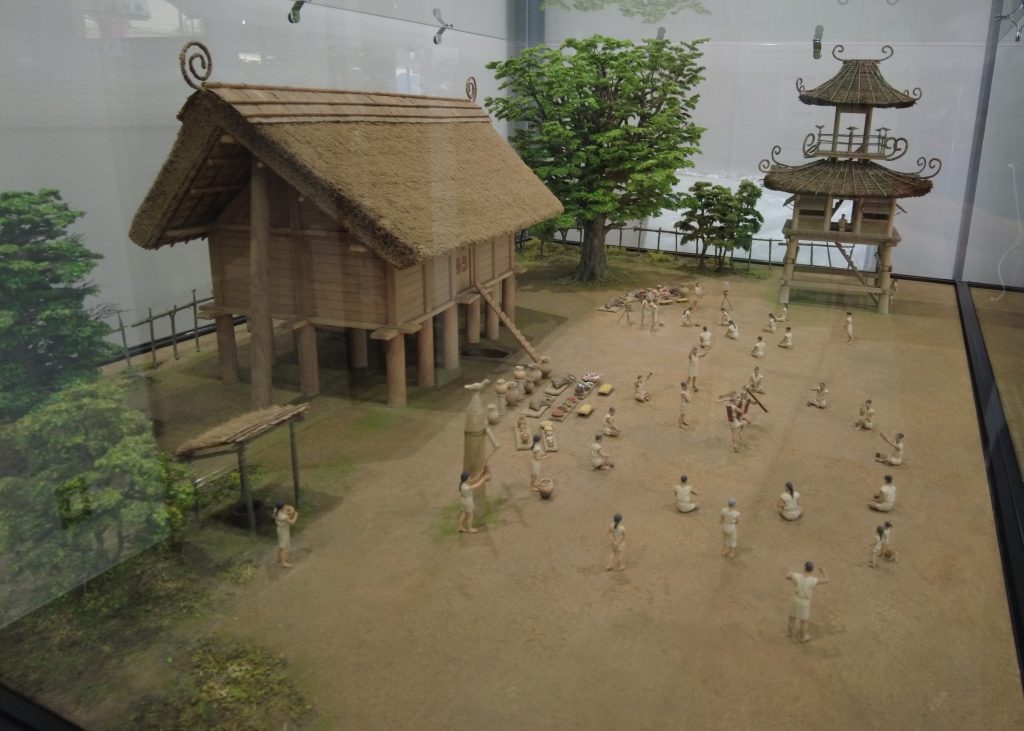
Model example Yayoi period life at the Karako-Kagi site.

Marked excavation site and recreated pillars from a large structure (see above model) at the Karako-Kagi site. The modern suburbs of Tawaramoto town surround this ancient space, creating a somewhat jarring contrast between 2 very different periods of human history in the Nara Basin.
Who are the Yayoi people?
Yayoi refers to a group of people who lived in Japan from roughly 300 BCE to 300 CE. They are thought to have differed from the previous inhabitants of the area (like the Jomon people), immigrating to Japan through the Korean Peninsula and starting agrarian societies all throughout the archipelago, largely relying on rice farming. The people who settled at the Karako-Kagi site are considered part of these Yayoi groups, and they are believed to have interacted and traded with other settled groups throughout Japan.
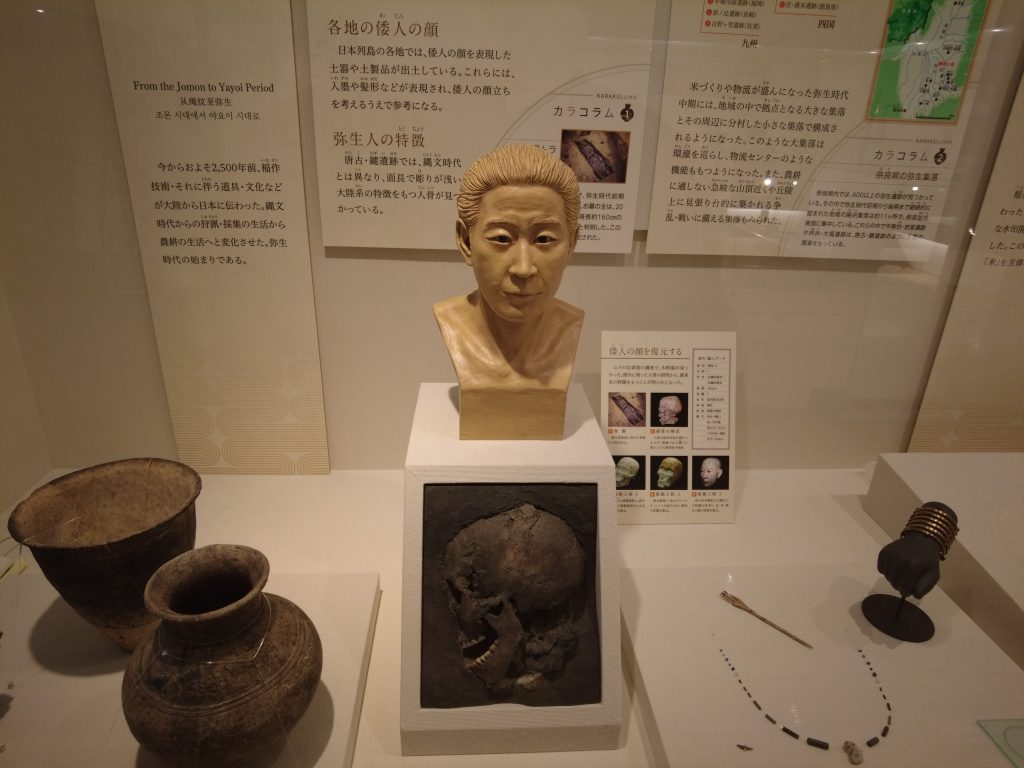
Recreated face of a person who lived at Karako-Kagi site around 2000 years ago (Karago-kagi Archeological Museum).
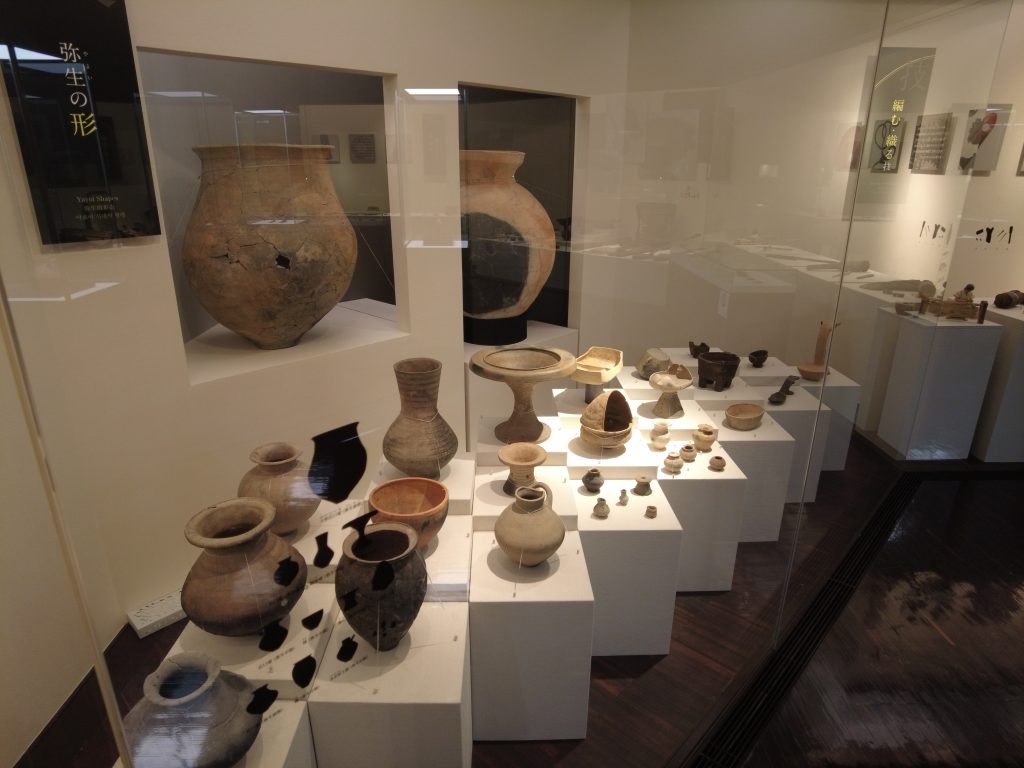
Examples of Yayoi pottery found at at the Karako-Kagi Archeological Museum.
Roots of kami worship (Shintoism)
It is believed that during the Yayoi period, nature worship was a popular form of spiritual practice in the Japanese archipelago. Though direct connection between this ancient form of nature worship and Japanese Shintoism are not entirely clear, the following Kofun and Asuka periods saw the establishment of major shrines dedicated to the purpose of worshiping deities of nature, such as Nara’s very own Omiwa Shrine, which is often called the oldest Shinto shrine in Japan, centered on a mountain deity who is important to rice cultivation, among other things.

Mt. Miwa, home of the Omiwa Shrine and a sacred mountain which has been venerated since ancient times.
The Legend of Queen Himiko
There are not many named historical figures from the Yayoi period, and the only contemporary sources of their existence comes from records created by officials in Han China. Among these accounts are those of a remarkable figure named “Himiko,” otherwise known as the “shaman queen” who united the warring kingdoms in the land of “Wa” (ancient Japan) under her rule. Himiko ruled over a country by the name of Yamatai and was the first of successive shaman queens who used their powers to commune with the divine and and predict the future, governing the country through divination.
A prevailing theory for Himiko’s name in Japanese is that it comes from the terms “sun (hi)” + “shaman (miko),” with miko still a common term, meaning “shrine maiden” that refers to a female priestess of a Shinto shrine. It is believed that miko had the exclusive role of communing with gods as mediums or shamans in early forms of Shintoism, similar to Queen Himiko. Furthermore, Himiko, as her name suggests, is said to have served the sun, which also is an important deity in Shintoism and a mythological ancestor to the Japanese Imperial Family itself. So, what could Himiko’s connection to this lineage, if any, actually be? This question, among many others relating to the formation of early Japan, is why the Yayoi period can be such fascinating period to study.
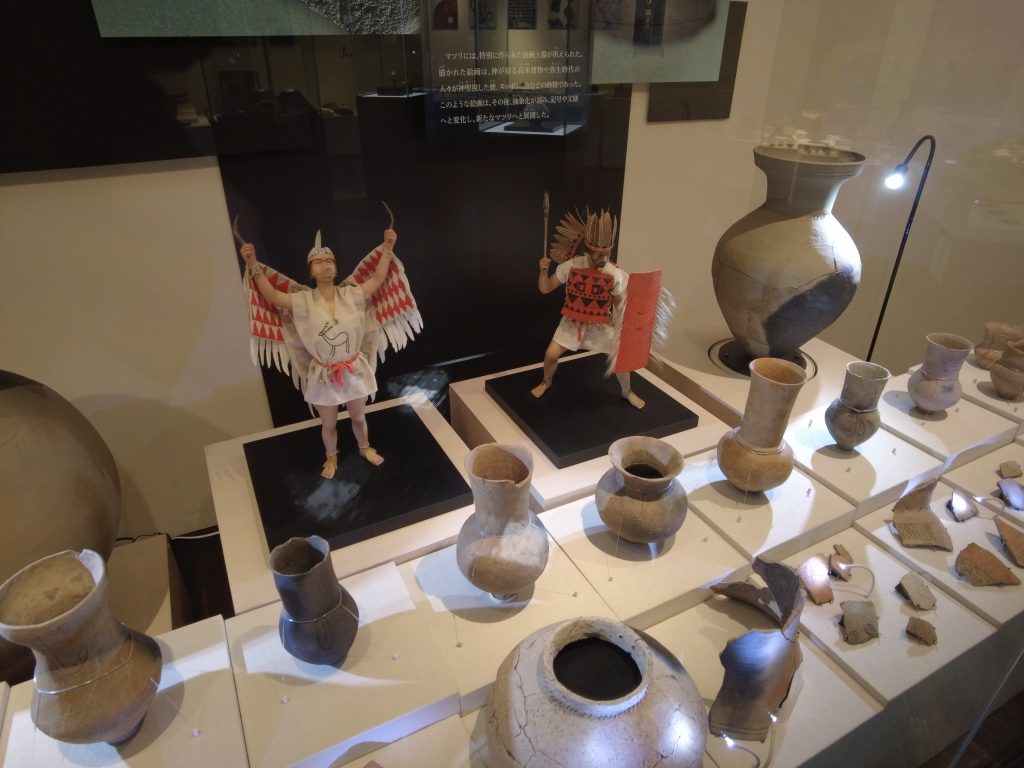
Model examples of Yayoi period people conducting a religious ceremony on display at the Karako-kagi Archeological Museum.
Karako-kagi Archeological Museum.
The museum, located a couple minutes by car to the south of the actual Karako-Kagi site itself, is also well worth the time to visit to see all the amazing artifacts excavated from the site that are on display. They are neatly organized into different categories, including pottery, food making tools, and items used for ritual purposes. There are also various model recreations that show the layout of what the town might have looked like and how folks might have dressed and organized roles in society. It is within this museum that one gets to truly begin to understand the day to day life of the people who once lived at the Karako-kagi site.
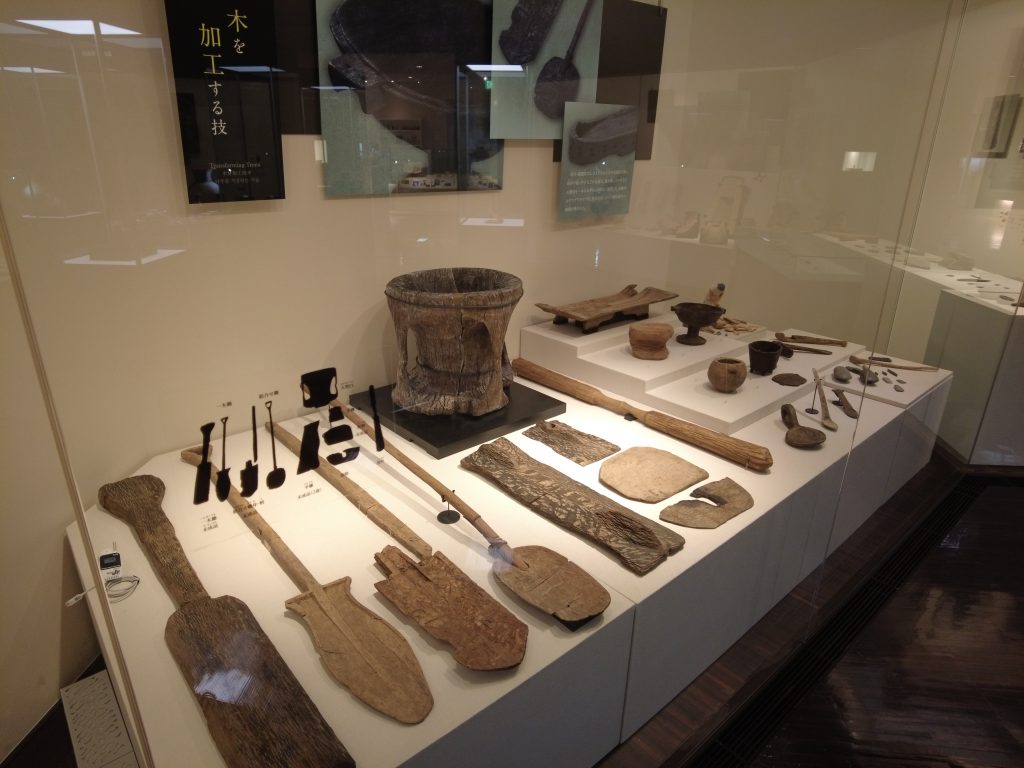
Excavated tools on display at the Karako-Kagi Archeological Museum.
One of the most impressive displays in the museum is the exhibition is of haniwa found at burial mounds around the area of Tawaramoto town. Haniwa is a type of early ceramic art form that emerged in the Kofun period (300 CE – 538 CE) that often depicts human-like and animal forms. One especially exceptional piece here, a haniwa sculpture of a cow, has been designated as an official Important Cultural Property due to its uniqueness. Though not extracted from the Karako-kagi site and from a different age, this special artwork on display is one of the highlights of visiting the museum.
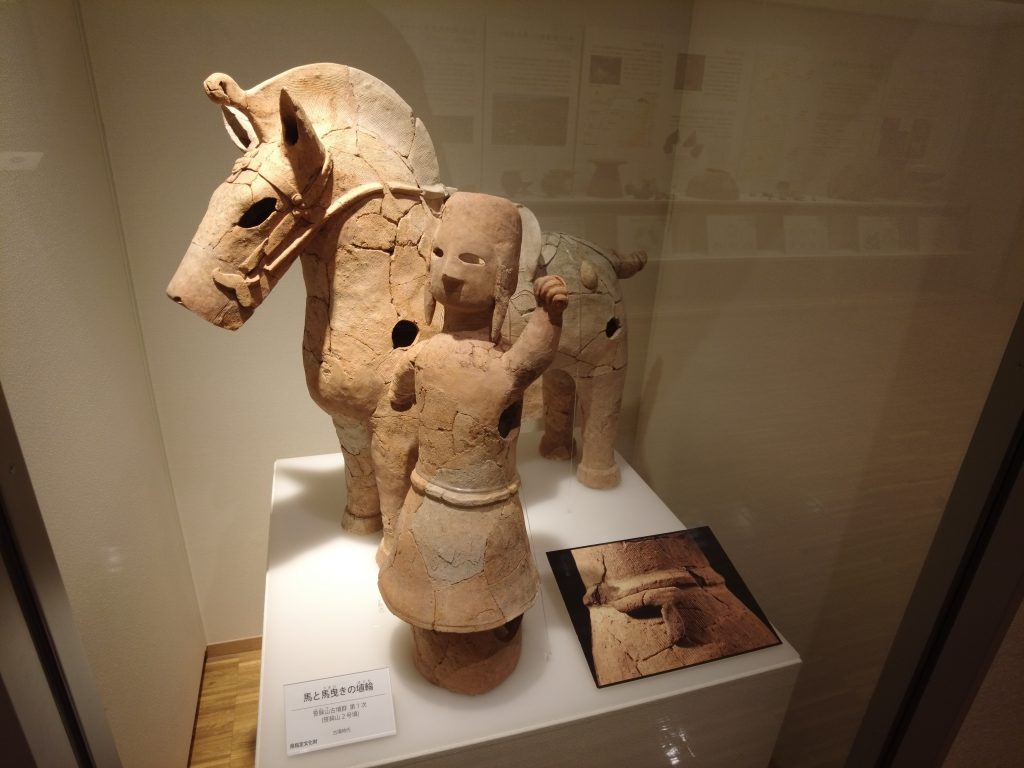
Haniwa ceramic artwork on display in the Karako-Kagi Archeological Museum.
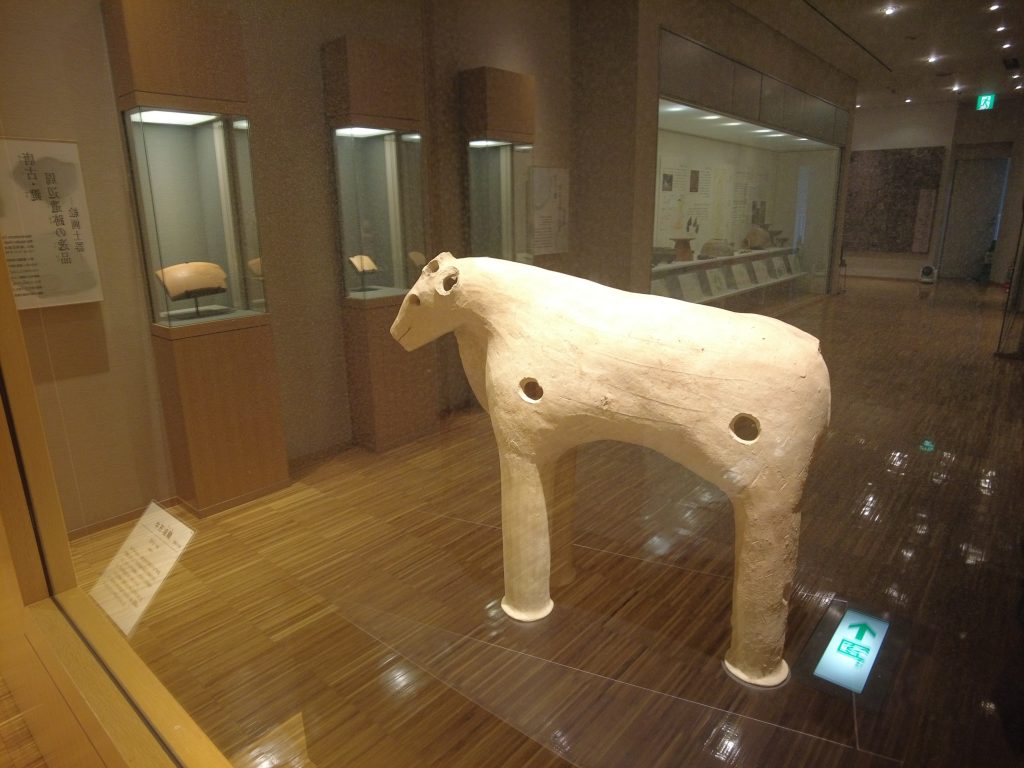
This one-of-a-kind haniwa sculpture of a cow is in amazing condition and has been designated as an Important Cultural Property.

Illustration of the Karako-Kagi site with some artifacts below. The middle wooden carving is an ancient ladder.
Access
Unfortunately, there is no train station next to either the Karako-Kagi site or the archeological museum. The nearest stations are Iwami Station or Tawaramoto Station, depending on which location you wish to go to first (about 15-20 min on foot from either station). It is worth noting that the Kintetsu Limited Express train at stops at Tawaramoto Station, for those who are coming from Osaka or other far away destinations and prefer not to use a slow local train.
Lastly, if you would like more information about the best way to visit Karako-Kagi, including overnight accommodation in the Tawaramoto area, guiding services, and so on, please feel free to contact us here at Kansai Treasure Travel anytime.

01
FIND YOUR FAVORITE
TRIP ON OUR WEBSITE.
SEND US AN INQUIRY.

02
PERSONALIZE THE TRIP
TO YOUR INTERESTS
WITH OUR CONSULTANT.

03
20% DEPOSIT TO CONFIRM.
BALANCE PRIOR TO ARRIVAL.
PAYMENT BY CC OR TT.

04
WE WILL
MEET YOU
AT THE AIRPORT.

05
DISCOVER THE
TREASURES!